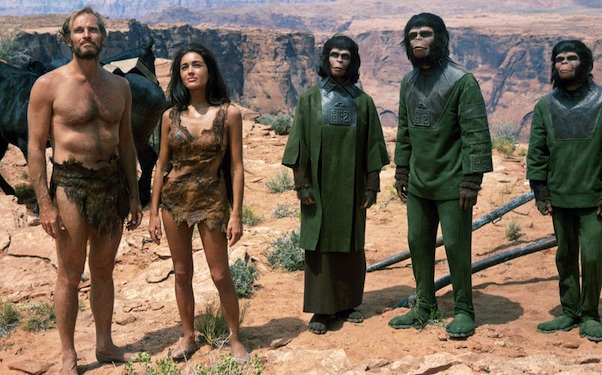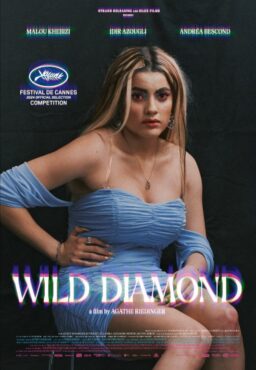“It’s a madhouse!” screams Charlton Heston’s imprisoned astronaut in “Planet of the Apes,” after suffering unending abuse at the hands of talking primates who treat him as a threat to their order. Almost fifty years after its release, the original “Planet of the Apes” still works because it, too, is a madhouse: up is down; black is white; ape on top, man in the dirt—or in jail.
This film is a classic, by which I mean, so fundamentally compelling that once you immerse yourself in it, you tend to accept its blatantly of-the-moment aspects—such as the once innovative but now obviously rubbery primate masks, Heston’s toothy declaiming, and the hero’s mute, gorgeous love interest (essentially a means of repopulating the species)—as aspects of its personality instead of deal-breakers. I saw it for the first time on TV in the late ’70s—I might have been ten or eleven—and found it unrelentingly intense, but today it looks like a model of stoic patience. The mid-twentieth-century rhythm of the storytelling might take some getting used to for newcomers, especially those introduced to the franchise via the superb, CGI-saturated, ape-centric films, or the over-scaled, undercooked 2001 Tim Burton remake. As a species whose brains have evolved a fast-forward button, we no longer have patience for movies that take their time conveying the idea of a Long Journey, as “Apes” does during its opening twenty minutes, following three stranded American astronauts as they wander on foot through a wasteland while their captain, cynic supreme George Taylor (Heston), grandstands about the irrevocability of their situation. Taylor is insufferable from frame one, the kind of seen-it-all blowhard you’d hate to sit next to in a bar. “Get to the apes,” some part of the brain might mumble.
But once the apes show up, oh man.
Directed by Franklin J. Schaffner (“Patton“) from a screenplay credited to “The Twilight Zone” creator Rod Serling and Michael Wilson, “Apes” feels like a very long but superb “Zone” episode, so clever and well-crafted that even if you figure out the twist right away (and “The Simpsons” aside, why wouldn’t you, as many times as that ending shot has been parodied?) you get pulled in by Taylor’s predicament, and by the storytelling. Serling and Wilson’s script, which adapted Pierre Bouelle’s more literary/explanatory source novel, balances adventure, horror, parable and satire with a deftness rarely attempted by Hollywood blockbusters today.
By modern studio-film standards, “Apes” is a small movie. Much of it plays out in contained spaces, in beautifully shaped scenes, like you’d see in superior stage production. Supposedly Serling’s original drafts described a more high tech society, but Twentieth Century Fox balked at the costs it would’ve entailed to realize them, so Wilson rewrote the script to make the apes more primitive, capable of building rifles and gunpowder and some medical technology but not much more. The intimacy of the whole thing proves an asset instead of a liability. It focuses the parable aspects. And it makes the broadly comic moments—such as Linda Harrison’s Nova flashing a rictus-like smile that Taylor taught her, or the three primates supervising Taylor’s trail responding to heretical statements by covering their eyes, ears and mouth—pop more. At its grimmest and most infuriating, the film’s dialogue evokes the bleak absurdism of “Catch-22” and Kafka; at its loopiest, it could have been an ongoing sketch featured by the Smothers Brothers or “Laugh-In.”
The main set, a village on the edge of a lake, looks (probably deliberately) like a zoo carved out of rock. The first section of the film has just three characters, the astronauts, and most of the action is no bigger in scope than what you’d see in a low-budget Western from the period. Once Taylor gets netted and tossed into the clink, he’s the only human character with a voice, and he loses that to a throat wound for a bit. During the long midsection, he’s studied by chimpanzee scientists (Kim Hunter’s Zira and Roddy McDowell’s Cornelius), and targeted for lobotomization and gelding by the orangutan Dr. Zaius (Maurice Evans), the Minister of Science and a devout proponent of the apes’ theology, which holds that God gave primates dominion over man.
It’s here that the movie feels most Serling-y, for the way that it deals in metaphors that are exact enough to draw chuckles of recognition from those who get the jokes, yet somehow also vague enough to feel open-ended, flexible, capable of being bent to all sorts of rhetorical ends. The official Rod Serling web site compares the film to the classic “Zone” episode “The Eye of the Beholder” and notes that the Statue of Liberty ending seems modeled on another Serling “Zone” script, “I Shot An Arrow Into the Air,” in which astronauts who think they’ve crash-landed on another planet discover they were on Earth all along. (Bouelle’s novel ends with the astronaut landing at an airport in Paris, and being met by a car with an ape in the driver’s seat—conceptually not far from the end of Burton’s remake.) A still bigger influence may have been George Orwell, one of Serling’s favorite writers and the author of two novels that strongly informed this film’s tone: “1984,” the source of such horrifying non-wisdom as “Ignorance is Strength,” and “Animal Farm.” The latter is paraphrased in the scene where Taylor calls the primates out on their intra-species bigotry by sneering, “Some apes, it seems, are more equal than others.”
“Planet of the Apes” and its four direct sequels have also been analyzed as a pretzel-logic twist on the story of American race relations. The once-slaves (primates, problematically enough) are elevated to the status of rulers when the once dominant culture (humans, standing in white Europeans) destroy themselves; the new ruling class replicates many sins of the old, including turning the subjugated class into animal-like Others in order to justify their poor treatment, while at the same time offering sensible justifications for wanting to suppress them. Whether this anti-racist parable is itself racist has been debated for decades now, to the point where it overshadows the movie’s more obvious agenda: warning the US and the former Soviet Union—then locked in an increasingly hot Cold War fought through espionage, proxy wars and nuclear proliferation—against burning the entire world to the ground.
Zaius’s habitual quoting of the Sacred Scrolls makes him a perfect foil for the reason-spouting, illusion-shattering Taylor, as well as a stand in for the self-serving ignorance of theocrats who take control of governments and then treat mysticism as if it were a form of skepticism. At the end of the film, when Zaius tells Cornelius, Zora and Taylor that their correct deductions about talking humans pre-dating ape society are just theories, it echoes everything from Middle Eastern theocracies quoting the Koran to justify the stoning of adulterers and the imprisonment of “heretic” filmmakers to US Christian evangelists getting elected to school boards and insisting that public schools teach a nonexistent “controversy” about evolution and the outlines of prehistoric life.
But when Zaius finally admits that he knows the truth about the now-extinct human civilization, his sentiments are not easily waved off. “The Forbidden Zone was once a paradise,” he tells Taylor. “Your breed made a desert of it, ages ago.” Taylor is pretty full of himself at that point, but he doesn’t protest too much, maybe because he remembers what he said to the ship’s recorder at the start of the film: “Does man, that marvel of the universe, that glorious paradox who sent me to the stars, still make war against his brother? Keep his neighbor’s children starving?” Seeing Lady Liberty smashed to pieces, Taylor falls into the surf and rails that “they did it,” but “they” is really “we.” Nothing in the film suggests that the blustering alpha male Taylor, left to his own devices, and with a pliant female to serve as incubator, would have built a society any less shortsighted, arrogant and cruel than the one that burned itself out.












